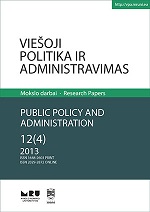Darbas ne visą darbo laiką Lietuvoje ir kitose ES šalyse: kitimo tendencijos ir pagrindinės problemos
Part-time Employment in Lithuania and Other EU Countries: Trends and Key Issues
Author(s): Rasa Zabarauskaitė, Boguslavas GruževskisSubject(s): Politics / Political Sciences
Published by: Mykolas Romeris University
Keywords: part-time employment; flexible forms of employment; working time
Summary/Abstract: Economic globalization and development of information technologies have had a significant impact on the utilisation of labour resources as well as on organization of work in many countries over the past decade. To balance the needs of production and labour resources, in the ninth decade of the 20th century, many countries introduced flexible forms of employment. Part-time employment is the most widely used flexible form of employment in many countries across the world. However, there are large differences existing in EU countries in terms of development of part-time employment, which requires a particular investigation. On the other hand, apart from benefits, part-time employment entails some drawbacks. The article aims at objectively assessing key advantages and disadvantages of part-time employment as well as analysing the dynamics of part-time employment in Lithuania and other EU countries. Key factors influencing part-time employment are analysed in the article, while putting a special focus on the regulation of part-time employment in Lithuania and the dynamics of part-time employment in some of the EU countries.
Journal: Viešoji politika ir administravimas
- Issue Year: 12/2013
- Issue No: 4
- Page Range: 540-556
- Page Count: 17
- Language: Lithuanian

